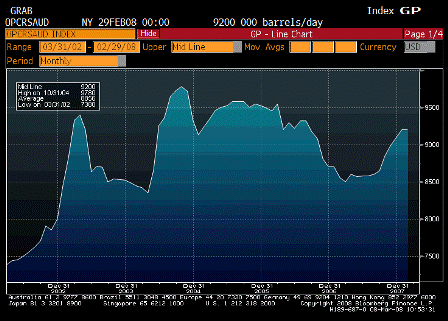CNBC just had a session on trying to reconcile high gdp with large credit losses. Seems they are now seeing the consumer clipping along at a +2.8% pace for Q4. No need to rehash my ongoing position that most if not all the losses announced in the last 6 months would have little or no effect on aggregate demand. Credit losses hurt demand when the result is a drop in spending. And yes, that happened big time when the subprime crisis took the bid away from would be subprime buyers who no longer qualified to buy a house. That probably took 1% away from gdp, and the subsequent increase in
exports kept gdp pretty much where it was. But that story has been behind us for over a year.
The Fed is not in a good place. They should now know that the TAF operation should have been done in August to keep libor priced where they wanted it. They should know by now losses per se don’t alter aggregate demand, but only rearrange financial assets. The should know the fall off in subprime buyers was offset by exports.
The problem was the FOMC- as demonstrated by their speeches and actions- did not have an adequate working understanding of monetary operations and reserve accounting back in August, and by limiting the current TAFs to $20 billion it seems they still don’t even understand that it’s about price, and not quantity. Too many members of the FOMC
are mostly likely in a fixed exchange rate paradigm, with its fix exchange rate/gold standard fractional reserve banking system that drove us into the great depression. With fixed exchange rates it’s a ‘loanable funds’ world. Banks are ‘reserve constrained.’ Reserves and consequently ‘money supply’ are issues. Government solvency is an issue.
With today’s floating exchange rate regime none of that is applicable. The causation is ‘loans create deposits AND reserves,’ and bank capital is endogenous. There are no ‘imbalances’ as all current conditions are ‘priced’ in the fx market, including ANY sized trade gap, budget deficit, or rate of inflation.
The recession risk today is from a lack of effective demand. There are lots of ways this can happen- sudden drop in govt spending, sudden tax increase, consumers change ‘savings desires’ and cut back spending, sudden drop in exports, etc.- and in any case the govt can instantly fill in the gap with net spending to sustain demand at any level it desires. Yes, there will be inflation consequences, distribution consequences, but no govt. solvency consequences.
So yes, there is always the possibility of a recession. And domestic demand (without exports) has been moderating as the falling govt budget acts to reduce aggregate demand. But the rearranging of financial assets in this ‘great repricing of risk’ doesn’t necessarily reduce aggregate demand.
Meanwhile, the Saudis, as swing producer, keep raising the price of crude, and so far with no fall off in the demand for their crude at current prices, so they are incented to keep right on hiking. And they may even recognize that by spending their new found revenues on real goods and services (note the new mid east infrastructure projects in progress) they keep the world economy afloat and can keep hiking prices indefinitely.
And food is linked to fuel via biofuels, and as we continue to burn up every larger chunks of our food supply for fuel prices will keep rising.
The $US is probably stable to firm at current levels vs the non commodity currencies, as portfolio shifts have run their course, and these shifts have driven the $ down to levels where there are ‘real buyers’ as evidenced by rapidly growing exports.
Back to the Fed – they have cut 100 bp into the triple negative supply shock of food, crude, and the $/imported prices, due to blind fear of ‘market functioning’ that turned out to need nothing more than an open market operation with expanded acceptable bank collateral (the TAF program). If they had done that immediately (they had more than one outsider and insider recommend it) and fed funds/libor spreads and other ‘financial conditions’ moderated, would they have cut?
There has been no sign of ‘spillover’ into gdp from the great repricing of risk, food and crude have driven their various inflation measures to very uncomfortable levels,and they now believe they have ‘cooked in’ 100 bp of inflationary easing into the economy that works with about a one year lag.
Merry Christmas!
♥

